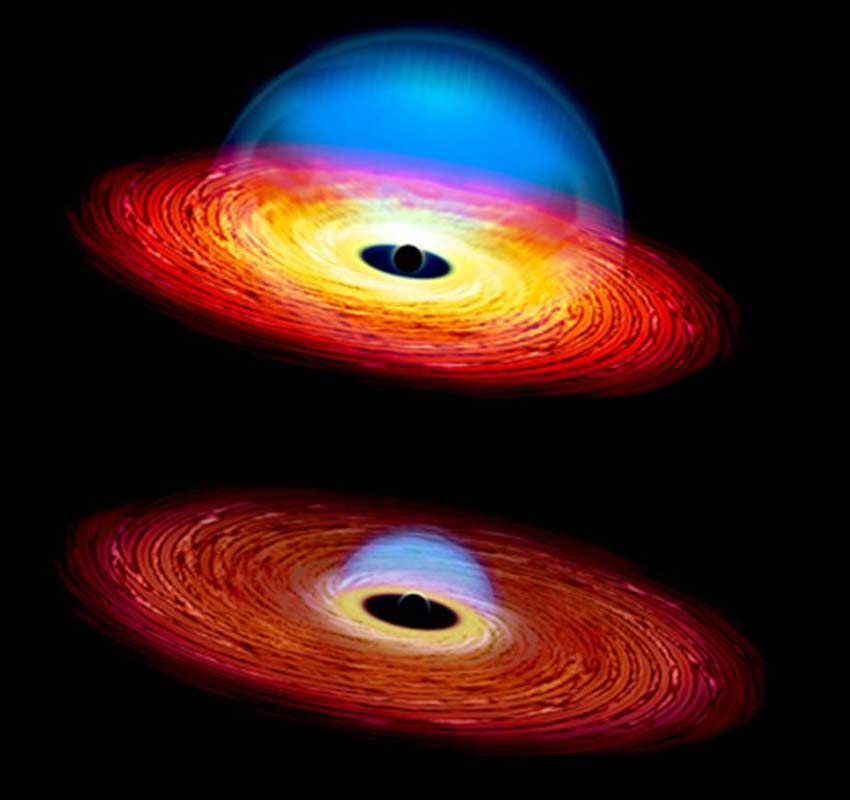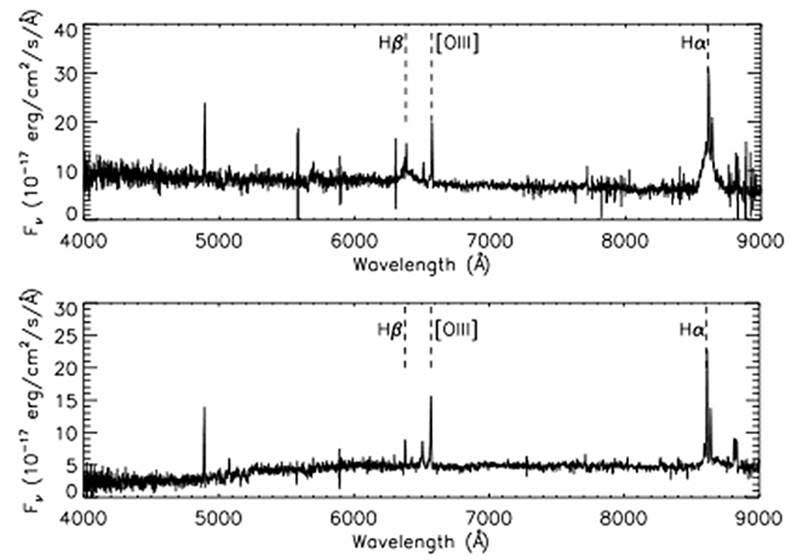A dozen quasars - the brightest furthest beacons of the early universe – have suddenly blinked out, forcing a rethink of conventional theory.
Dr Mae-Wan Ho

Stephanie LaMassa at Yale University had a shock when she found two radically different spectra of the same quasar J015957.64+003310.5 measured ten years apart in 2000 and in 2010 [1]. The object had dimmed to one-tenth of its former brightness. There were also drastic changes to its emission lines. The broad emission hydrogen component H-b had disappeared entirely and H-a substantially weaker (Figure 1). In fact, the quasar looks “almost like a galaxy.”

Figure 1 The quasar’s spectrum in 2000 (top) and in 2010 (bottom)
In July 2014, they confirmed that it was still just as dim, disproving hypotheses that suggested the effect was simply due to intervening gas or dust obscuring the quasar [2]
According to conventional Big Bang theory, a quasar arises from a distant (and therefore very old) galaxy that once contained a central, rotating supermassive black hole – an active galactic nucleus [2]. “This spinning beast ravenously swallowed up large amounts of ambient gas and dust, kicking up surrounding material and sending it streaming out of the galaxy at blistering speeds. Quasars shine because these ancient jets achieved tremendous energies, thereby giving rise to a torrent of light so powerful that astronomers are still able to detect it here on Earth, billions of years later.” So how could a quasar blink off in a matter of ten years or less?
The finding was written up by the team [3]. Quasars belong to a class of astronomical objects called active galactic nuclei (AGN) found at the centre of galaxies where a supermassive black hole is believed to be accreting matter. Quasars are classified with Type 1 AGNs, which show characteristic broad and narrow emission lines in their spectrum, as distinct from Type 2 AGNs, which lack broad emission lines. And the Types were thought to be distinct.
Nevertheless, astronomers suspect that all quasars, common the early universe, will eventually transition into ordinary galaxies: over tens of thousands of years when black holes run out of gas and dust to swallow, so quasars dim and grow quiescent [4]. And in the same way, it would take a similar amount of time for quasars to fire up (see later).
Type 1 to Type 2 AGN transition has been seen before, and referred to as ‘changing-look’ AGNs. But it is the first time that a ‘changing-look’ quasar has been caught in the act of turning from a Type 1 quasar - the furthest, most luminous quasar possessing a high redshift of 0.31 putting it at a distance of 1 624 Mpc or 5.3 billion light years from Earth – into a Type 1.9 AGN within such a short time (see [5] Supermagnetic Field or 'Supermassive Black Hole' , SiS 67) for an explanation of how redshift is translated into distance, erroneously). All previous changing-look AGNs had redshifts well below 0.1.
Serendipitously, X-ray observations were available for J015957.64+003310.5 in 2000 and 2010, showing a drop of flux by a factor of 6, similar to the drop in optical emissions.
LaMassa gave a talk at the January 2015 American Astronomical Society meeting in Seattle. This stimulated 3 additional teams to conduct their own search for further examples. Each team have since posted papers to arXiv - one led by Jessie Runnoe at Penn State, one by John Ruan at University of Washington, and the third by Chelsea MacLeod at University of Edinburgh in the UK – reporting a dozen new examples, all found using different methods [4].
If the quasar has turned into an ordinary galaxy, has the black hole suddenly disappeared? No, the authors suggest that it is the ability of the central engine – the black hole – to ionize gas in its vicinity that has shut down as all the gas disappears forever into the black hole.
Or as the Sloan Digital Sky Survey press release tells us on the discovery of yet another changing-look quasar [6]:“Astronomers can’t find any sign of the black hole at the centre of the quasar SSDSJ1011+5442, and they couldn’t be happier…The black hole is still there, of course, but over the past ten years, it appears to have swallowed all the gas in its vicinity,.. [and the quasar] now appears as an otherwise normal galaxy.” This is the first time we’ve seen a quasar shut off this dramatically, this quickly”, says Jessie Runnoe a Pennsylvania State University, the study’s lead author.
SDSS’s survey first measured a spectrum of the quasar in January 2003 to understand the properties of the gas being swallowed by the black hole. In particular, the strength of the prominent H-a line shows how much gas is falling into the central black hole. The SDSS measured another spectrum in early 2015.
“The difference was stunning and unprecedented”, said John Ruan at University of Washington, lead author of a related paper and member of Runnoe’s team. “The hydrogen-alpha emission dropped by a factor of 50 in less than twelve year, and the quasar now looks like a normal galaxy.”
The team’s conclusion is that the quasar has used up all the glowing hot gas in its immediate vicinity, leading to rapid drop in brightness.
This disappearing quasar is the first major discovery of the Time-Domain Spectroscopic Survey (TDSSO), one of the components of the SDSS’s fourth phase.
In the write-up of their findings [7], the team reported a drop in 5100 Å monochromatic continuum luminosity of the quasar by a factor of > 9.8 in 9.7 years while the broad H-a luminosity drops by a factor of 55 in the same period (Figure 2). The quasar has a redshift of z = 0.246; but the change is more dramatic than the first (Fig. 1).

Figure 2 Spectrum taken 2003 (upper trace) and 2014 (lower trace); black data, red, model of data
Light curves obtained in the Catalina Sky Survey from the quasar over the same period further suggest that the main transition occurs within ~500 days between 2009 and 2011, hardly an astronomical epoch. And these changes are by no means rare.
The third team led by Chelsea MacLeod carried out a systematic search for changing-look quasars [8] from SDSS and repeat spectra and in another survey Pan-STARR (the Panoramic Survey Telescope and Rapid Response System) [9], consisting of astronomical cameras, telescopes and a computing facility surveying the sky for moving/changing objects on a continual basis.
Objects with large changes in brightness (> 1 mag, a factor of ~2.5) are selected to look for changes in broad emission line (BEL) [8]. Out of a sample of 1 011 objects that satisfy the selection criteria and have more than one epoch of spectroscopy, 10 examples of quasars with changing-look BELs were found. Interestingly, 4 of them have emerging BELs, 5 have disappearing BELs, and one appears to have both emerging and disappearing BELs. Thus, quasars can change in either direction, they can blink on or off, or on and off at the same time. The redshifts are in the range of 0.2 < z <0.63. The sample includes the highest redshift changing-look quasar discovered to-date.
These findings are completely at odds with conventional theory in terms of ‘supermassive black holes’ as the ‘central engines’ of quasars. The rapid changes are by no means surprising if instead of hypothetical black holes, it is electromagnetic plasma that powers the formation of galaxies, quasars and stars alike in a cosmic electricity grid (see [10] Electric Plasma Universe Arrives and other articles in the series, SiS 68). But the greatest error concerning quasars (and other astronomical objects) is in assuming that their redshifts translates into distance from Earth in a rapidly expanding universe [5]. We shall re-examine a theory on the evolution of quasars and galaxies that has been ignored and suppressed for over half a century [11] (Halton Arp’s Theory of Quasars Re-visited, and other articles in the series, SiS 70).
Article first published 24/02/16
Comments are now closed for this article
There are 3 comments on this article.
Frank Rumore Comment left 26th February 2016 07:07:04
I laughed out loud to read "almost like a galaxy' because I was already intending to suggest that the late, great Halton Arp is even more than likely to be correct about his ignored theories.
Aquifer Comment left 27th February 2016 18:06:10
Just read your termination notice - so sorry for the reason - Hope Dr. Mae-Wan Ho recovers from her illness ...
This is a great site and its contributions to the understanding of many things will be missed -
The best to you ...
Christine Van Hooft Comment left 2nd March 2016 01:01:02
I will forever be grateful for Dr. Mae Wan-Ho's article on Quantum Coherence and many, many other articles that I have enlightened and touched so many throughout the Universe. May you find the depth of Strength and Peace as you journey through this health challenge. May you carry in your heart the respect and love that I united the scientist and the layperson and remember always that the seeds of knowledge you have planted will grow and come to a beautiful and bountiful harvest.